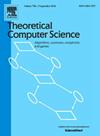Hypergraph burning, matchings, and zero forcing
IF 1
4区 计算机科学
Q3 COMPUTER SCIENCE, THEORY & METHODS
引用次数: 0
Abstract
Lazy burning is a recently introduced variation of burning where only one set of vertices is chosen to burn during the first round. In hypergraphs, lazy burning spreads when all but one vertex in a hyperedge is burned. The lazy burning number is the minimum number of initially burned vertices that eventually burn all vertices. We give several equivalent characterizations of lazy burning on hypergraphs using matchings and zero forcing, and then apply these to establish new bounds and complexity results.
We prove that the lazy burning number of a hypergraph H equals its order minus the maximum cardinality of a certain matching on its incidence graph. Using this characterization, we give a formula for the lazy burning number of a dual hypergraph and give new bounds on the lazy burning number based on various hypergraph parameters. We show that the lazy burning number of a hypergraph may be characterized by a maximal subhypergraph that results from iteratively deleting vertices in singleton hyperedges.
We prove that lazy burning on a hypergraph is equivalent to zero forcing on its incidence graph and show an equivalence between skew zero forcing on a graph and lazy burning on its neighborhood hypergraph. As a result, we show that the decision problem of computing the lazy burning number of a hypergraph is NP-complete, which solves an open problem in [12]. By applying the results found for lazy burning, we show that the decision problem of computing the skew zero forcing number for bipartite graphs is NP-complete. We finish with open problems.
超图燃烧、匹配和零强迫
惰性燃烧是最近引入的燃烧的变体,在第一轮中只选择一组顶点进行燃烧。在超图中,当超边中除一个顶点外的所有顶点都被燃烧时,惰性燃烧会扩散。惰性燃烧数是最初燃烧顶点的最小数量,最终燃烧所有顶点。我们利用匹配和零强迫给出了超图上延迟燃烧的几个等价特征,然后应用这些特征建立了新的边界和复杂度结果。证明了超图H的惰性燃烧数等于它的阶数减去它的关联图上某个匹配的最大基数。利用这一特性,我们给出了对偶超图的延迟燃烧数的公式,并给出了基于各种超图参数的延迟燃烧数的新界。我们证明了一个超图的惰性燃烧数可以用一个极大的子超图来表征,这个子超图是由迭代地删除单个超边上的顶点而得到的。证明了超图上的惰性燃烧与关联图上的零强迫是等价的,并证明了图上的偏零强迫与其邻域超图上的惰性燃烧是等价的。结果表明,计算超图的延迟燃烧数的决策问题是np完全的,解决了[12]中的一个开放问题。通过应用延迟燃烧的结果,我们证明了计算二部图的偏零强迫数的决策问题是np完全的。我们以开放问题结束。
本文章由计算机程序翻译,如有差异,请以英文原文为准。
求助全文
约1分钟内获得全文
求助全文
来源期刊

Theoretical Computer Science
工程技术-计算机:理论方法
CiteScore
2.60
自引率
18.20%
发文量
471
审稿时长
12.6 months
期刊介绍:
Theoretical Computer Science is mathematical and abstract in spirit, but it derives its motivation from practical and everyday computation. Its aim is to understand the nature of computation and, as a consequence of this understanding, provide more efficient methodologies. All papers introducing or studying mathematical, logic and formal concepts and methods are welcome, provided that their motivation is clearly drawn from the field of computing.
 求助内容:
求助内容: 应助结果提醒方式:
应助结果提醒方式:


